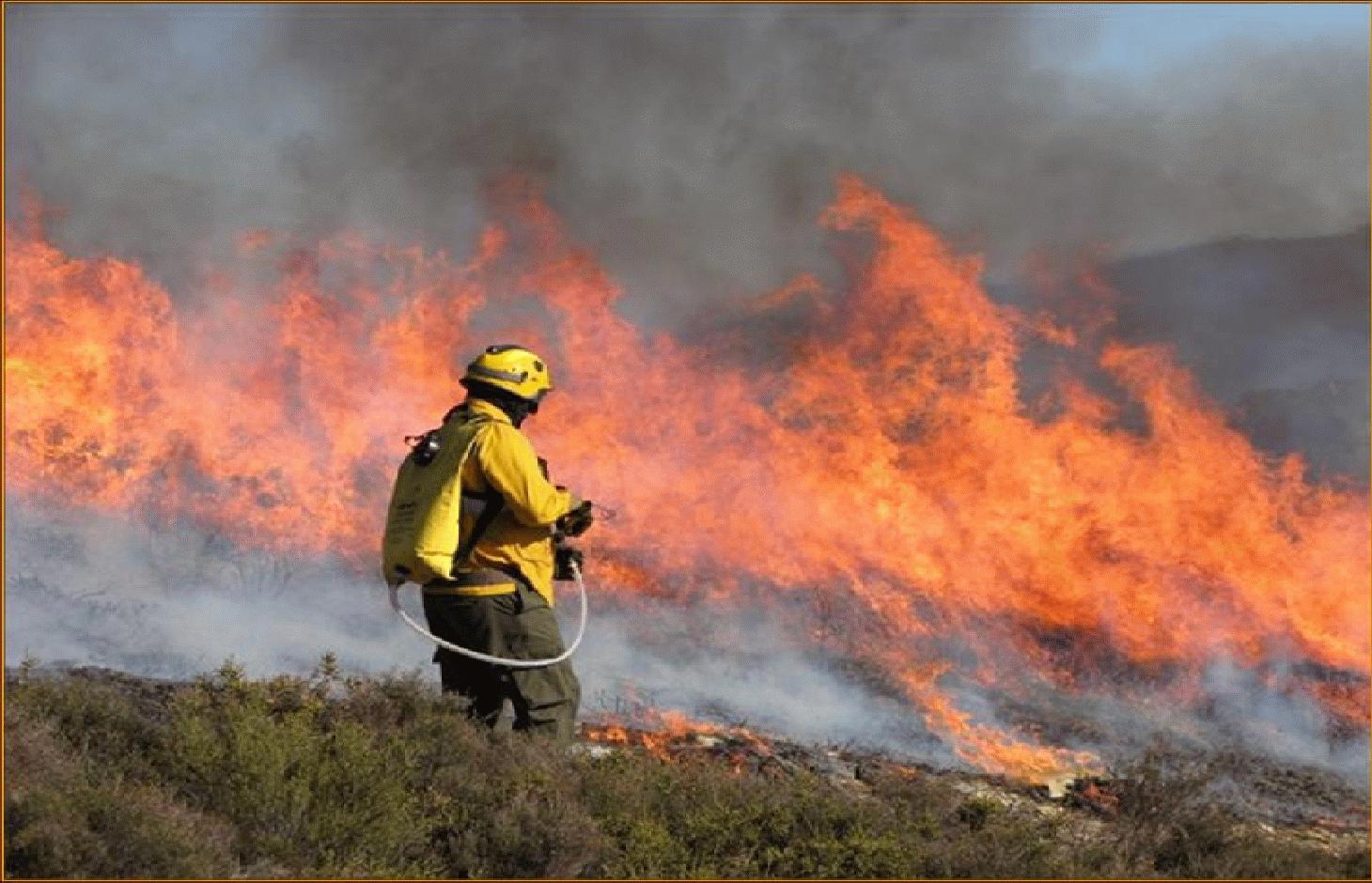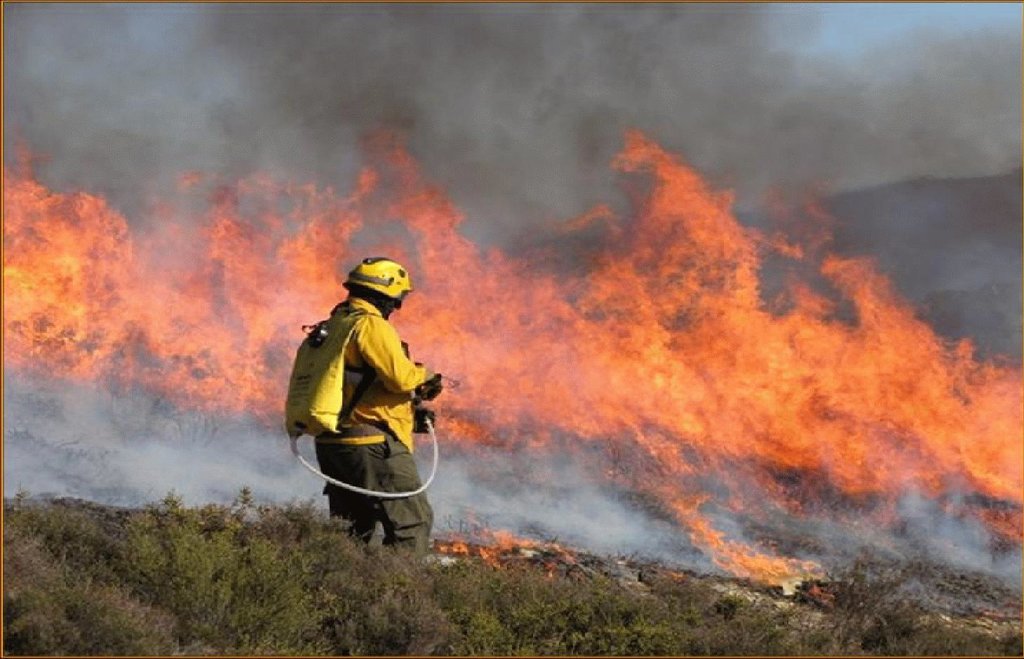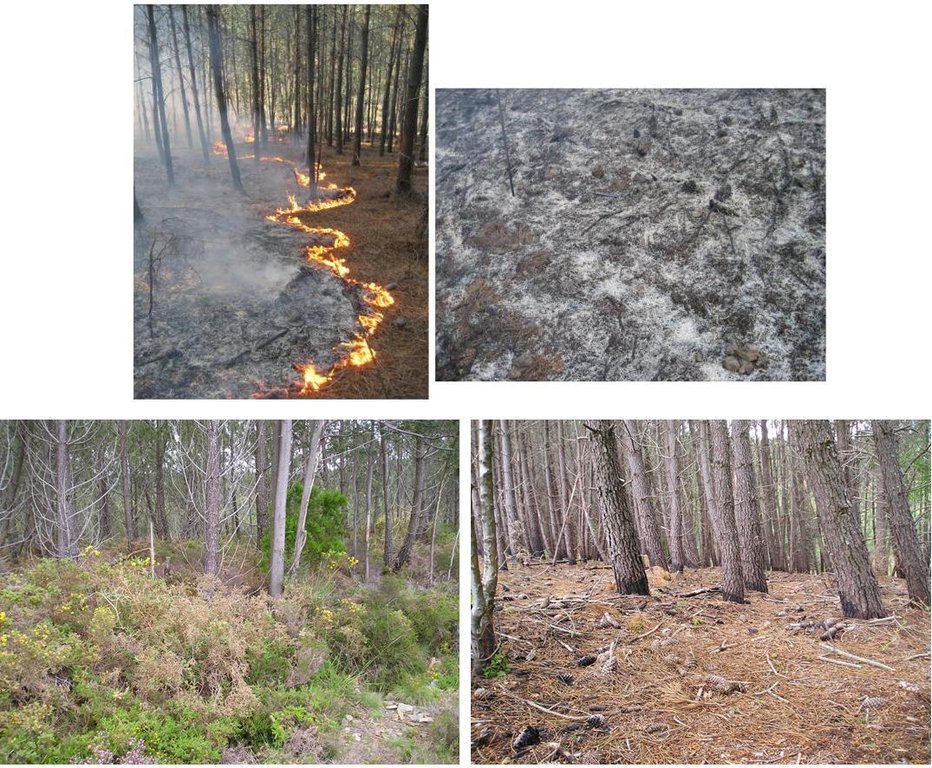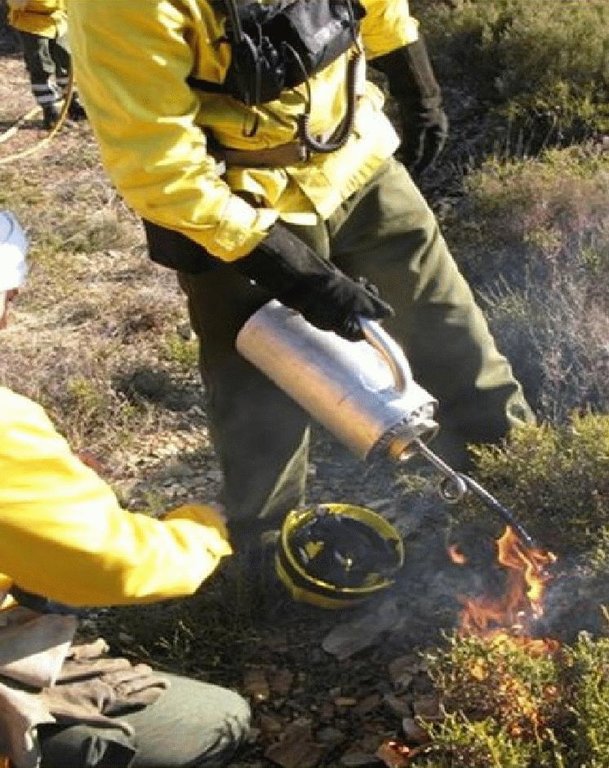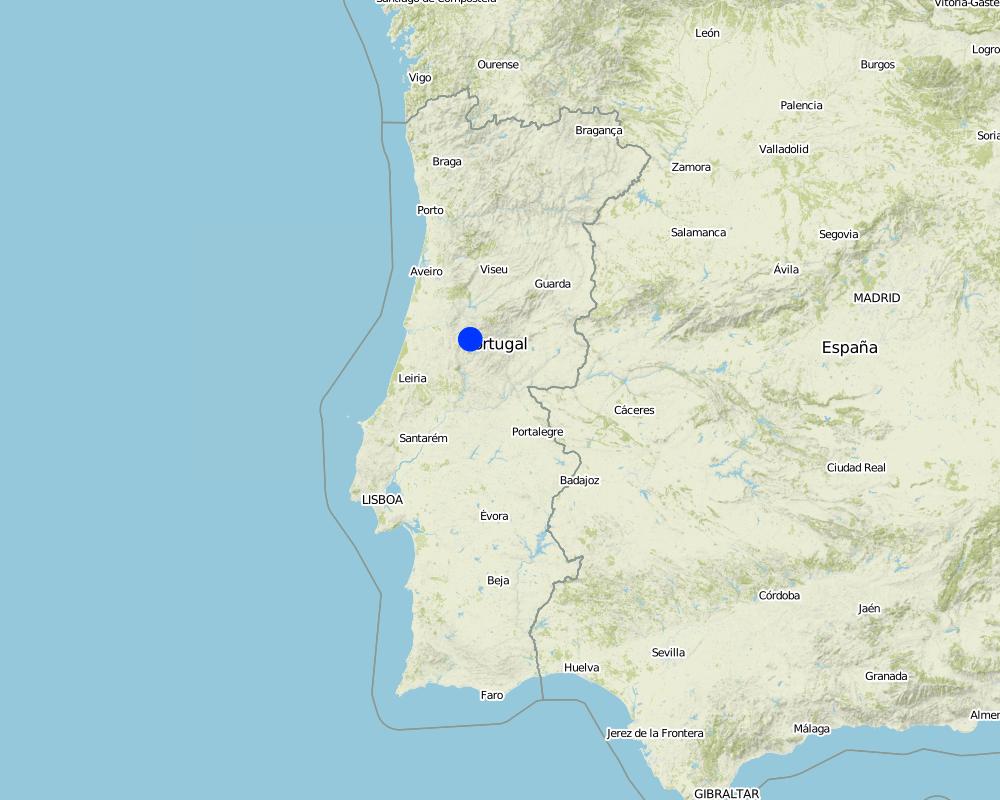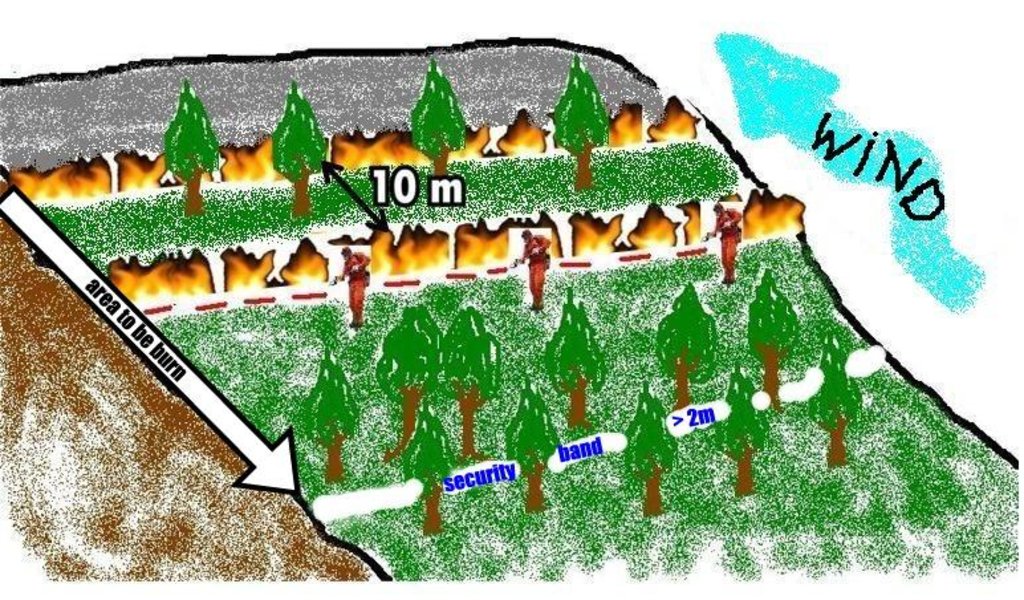Prescribed fire [البرتغال]
- تاريخ الإنشاء:
- تحديث:
- جامع المعلومات: Manuela Carreiras
- المحرر: –
- المُراجع: Deborah Niggli
Fogo Controlado
technologies_1534 - البرتغال
عرض الأقسام
توسيع الكل طي الكل1. معلومات عامة
1.2 تفاصيل الاتصال بالأشخاص الرئيسيين لمصدر المعلومات والمؤسسات المشاركة في تقييم وتوثيق التقنية
متخصص في الإدارة المستدامة للأراضي:
اسم المشروع الذي سهّل توثيق/تقييم التقنية (إذا كان ذلك على صلة)
DESIRE (EU-DES!RE)اسم المؤسسة (المؤسسات) التي سهلت توثيق/تقييم التقنية (إذا كان ذلك على صلة)
Centro de Estudos de Rescursos Naturais, Ambiente e Sociedade (CERNAS) - البرتغال1.3 الشروط المتعلقة باستخدام البيانات الموثقة من خلال WOCAT
متى تم تجميع البيانات (ميدانيا)؟:
09/12/2011
يوافق جامع المعلومات والشخص (لاشخاص) الرئيسي لمصدر المعلومات على الشروط المتعلقة باستخدام البيانات الموثقة من خلال WOCAT:
نعم
1.5 الإشارة إلى الاستبيان (الاستبيانات) حول مناهج الإدارة المستدامة للأراضي
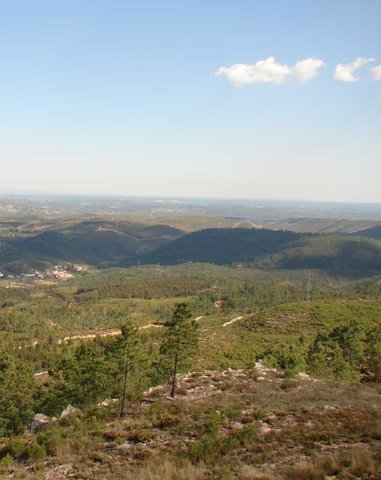
Forest Intervention Area (ZIF) [البرتغال]
Forest Intervention Area (ZIF) is a territorial unit, where the main land use is forestry. This approach assembles and organizes small forest holders and defines a joint intervention for forest management and protection. Defined by law in 2005, and revised in 2009, each ZIF of private forest has to include …
- جامع المعلومات: Celeste Coelho
2. وصف تقنيةالإدارة المستدامي للأراضي
2.1 وصف مختصر للتقنية
تعريف التقنية:
Use of prescribed fire (or ‘controlled burn’) to reduce the fuel load in the form of live and dead plant material and thus to prevent the likelihood of more damaging wildfire.
2.2 وصف تفصيلي للتقنية
الوصف:
This technique is an essential management tool that applies fire to control the quantity of forest or scrubland fuels. The type of fire depends on the specific goals and on the weather conditions. Firstly, it is important to consider slope angle and the kind of fuels to be burned. Weather conditions include temperature, wind direction and air humidity. Another important aspect is the ability to control the speed of flame spread. In order to carry out the controlled fire, a plan has to be drawn up and approved and a fully-trained, authorised technician must be present in addition to the appropriate support teams (fire fighters, forest management teams). These teams use water or other means of combating the fire in the event of it possibly getting out of control and are in charge of the burning process.
Purpose of the Technology: The main purposes are enhancement of grazing areas and the creation of the so-called primary network for wildfire defence, which is a national network to limit the spread of wildfire. It involves strategically burning key sites (e.g. mountain ridges) to restrict the spread of the wildfire.
Establishment / maintenance activities and inputs: An analysis of weather conditions is made prior to carry out the prescribed fire. On the day of the prescribed fire itself, safety checks are made and the specific tasks of all the team members are defined. Wind direction and strength need to be minimal and are strictly controlled during burning. The size of the team depends on the specific problems of the area to be treated. Team size needed for about 10 ha is around 10 persons. The team members start along a line working from the top on the mountain along the contour and move downwards. Gentle breeze should be against the direction of the spreading of the fire. Workers use a drip-feed fuel can. There is also a strategy for prescribed fires by burning a strip along ridges of the mountains to avoid spreading of accidental wildfires and to burn in catchments the lowest point from which fire can spread to different areas and spread in different directions on the slopes.
Natural / human environment: Improved grazing management might also reduce the fuel load. Abandoning grazing in the forest can increase the fuel load and aggravate the occurrence and impact of wildfires. The creation or maintenance of grazing areas is determined by the size of the herd. Prescribed fire used as a means of improving grazing enables the local population needs to be addressed while considering environmental concerns. The prescribed fire also helps to protect the local population and their property by reducing the likelihood of devastating wildfire.
2.3 صور التقنية
2.5 البلد/المنطقة/المواقع التي تم تنفيذ التقنية فيها والتي يغطيها هذا التقييم
البلد:
البرتغال
المنطقة/الولاية/المحافظة:
Castanheira de Pêra
مزيد من التفاصيل حول الموقع:
Leiria
Map
×2.6 تاريخ التنفيذ
في حالة عدم معرفة السنة بالتحديد، يرجى الإشارة إلى التاريخ التقريبي:
- منذ أكثر من 50 عامًا (تقليدي)
2.7 إدخال التقنية
حدد كيف تم إدخال التقنية:
- كجزء من النظام التقليدي (> 50 عامًا)
3. تصنيف تقنية الإدارة المستدامي للأراضي
3.2 نوع (أنواع) استخدام الأراضي الحالية حيث يتم تطبيق التقنية

أراضي الرعي
أراضي الرعي الواسع النطاق:
- رعي شبه مرتحل

الغابات/ الأراضي الحرجية
- Shrublands/pasture
منتجات وخدمات:
- الخشب
- الرعي/ رعي أطراف الأشجار الفتية (الجلح)
التعليقات:
Major land use problems (compiler’s opinion): The problem is linked to the loss of traditional natural pasture use. Since there is nowadays no grazing/pasture use of forests, the fuel load remains uncontrolled. It is also linked to minimising wildfire impacts and the creation of grazing land. As more people visit forest areas for leisure and accidentally set fire. Another problem is vandalism and arson.
Semi-nomadism / pastoralism: Yes
Other type of forest: Shrublands/pasture
Forest products and services: timber, grazing / browsing
3.3 مزيد من المعلومات حول استخدام الأراضي
إمدادات المياه للأرض التي يتم تنفيذ التقنية عليها:
- بعلية
كثافة الثروة الحيوانية (إذا كانت ذات صلة):
< 1 LU/km2
3.4 مجموعةالإدارة المستدامة للأراضي التي تنتمي إليها هذه التقنية
- إدارة الغابات الطبيعية وشبه الطبيعية
- Prescribed fire
3.5 انتشار التقنية
التعليقات:
Total area covered by the SLM Technology is 0.57 m2.
3.6 التدابير التقنية في مجال إلادارة المستدامة للأراضي

التدابير الإدارية
- M5: التحكم في/تغيير تركيبة الأنواع
التعليقات:
Main measures: management measures
3.7 الأنواع الرئيسية من تدهور الأراضي التي تناولتها التقنية

التدهور البيولوجي
- (Bf): الآثار الضارة للحرائق
التعليقات:
Main type of degradation addressed: Bf: detrimental effects of fires
Main causes of degradation: deforestation / removal of natural vegetation (incl. forest fires), other natural causes (avalanches, volcanic eruptions, mud flows, highly susceptible natural resources, extreme topography, etc.) specify (Wildfire), population pressure (An decline of population during the last decades resulting in less grazing contributes to increased wildfire risk.)
3.8 منع أو حد أو عكس تدهور الأراضي
تحديد هدف التقنية فيما يتعلق بتدهور الأراضي:
- الحد من تدهور الأراضي
التعليقات:
Main goals: mitigation / reduction of land degradation
4. المواصفات الفنية، وأنشطة التنفيذ، والمدخلات، والتكاليف
4.1 الرسم الفني للتقنية
4.2 المواصفات الفنية/شروحات الرسم الفني
Prescribed fire is a practice used to manage vegetation in wildfire-prone areas. It consists of slowly burning strategic areas in the wet season, under specific weather and ground conditions and procedures: the soil should be moist, burning typically carried out in thin strips (normally 10m distance between two fire lines) from the top to the bottom of the slope, there should be only a gentle breeze blowing upslope and the ignition points should be 2m apart along the contour. The fire is allowed to progress downslope against the wind, which therefore provides some control. Burning is achieved by a number of the team who are prepared to dowse the flames if the fire gets out of hand. This degree of control is only possible when burning small areas with the same slope angle.
Location: Castanheira de Pêra. Leiria, Portugal
Date: January, 2009
Technical knowledge required for field staff / advisors: high (Specific training)
Technical knowledge required for land users: low
Technical knowledge required for Fire men: moderate
Main technical functions: control of fires, reduction of dry material (fuel for wildfires), spatial arrangement and diversification of land use
Secondary technical functions: control of dispersed runoff: impede / retard, increase of infiltration
Layout change according to natural and human environment
4.3 معلومات عامة بخصوص حساب المدخلات والتكاليف
عملة أخرى/ عملة وطنية (حدد):
EURO
أشر إلى سعر الصرف من الدولار الأمريكي إلى العملة المحلية (إذا كان ذا صلة): 1 دولار أمريكي =:
136,94
اذكر متوسط تكلفة أجر العمالة المستأجرة في اليوم الواحد:
100.00
4.4 أنشطة التأسيس
| النشاط | نوع التدبير | التوقيت | |
|---|---|---|---|
| 1. | Planning and implementation | إدارية | 1 morning (5h) |
| 2. | Fire control equipment | إدارية | |
| 3. | Monitoring prescribed fire | إدارية | 1 morning (5h) |
4.5 التكاليف والمدخلات اللازمة للتأسيس
| تحديد المدخلات | الوحدة | الكمية | التكاليف لكل وحدة | إجمالي التكاليف لكل مدخل | % من التكاليف التي يتحملها مستخدمو الأراضي | |
|---|---|---|---|---|---|---|
| العمالة | Labour | ha | 1,0 | 25,0 | 25,0 | |
| معدات | Machine use | ha | 1,0 | 25,0 | 25,0 | |
| إجمالي تكاليف إنشاء التقنية | 50,0 | |||||
4.6 الصيانة/الأنشطة المتكررة
| النشاط | نوع التدبير | التوقيت/الوتيرة | |
|---|---|---|---|
| 1. | No maintenance is necessary. Every 3 to 5 years, prescribed fire is carried out again, repeating the process described abovet. | إدارية | On 3-4 or 4-5 years |
4.7 التكاليف والمدخلات اللازمة للصيانة/للأنشطة المتكررة (سنويًا)
التعليقات:
Calculation of costs has been made based on the prescribed fire conducted for the DESIRE project. They represent the costs to burn 3-4ha, during a morning and including human resources (12 people), equipment (fire torch, fuel, special fire protection clothing, scythes, and hoses) and specialized fire fighting vehicles.
4.8 أهم العوامل المؤثرة على التكاليف
قدم وصفا لأهم العوامل التي تؤثر على التكاليف:
Prescribed fire costs: timing, the right number in the team, fuel type and specific local conditions (slope and vegetation) are the most important determining factors affecting the costs.
5. البيئة الطبيعية والبشرية
5.1 المناخ
هطول الأمطار السنوي
- < 250 مم
- 251- 500 ملم
- 501 - 750ملم
- 1,000-751 ملم
- 1,500-1,100 ملم
- 2,000-1,500 ملم
- 3,000-2,001 ملم
- 4,000-3,100 ملم
- > 4000 ملم
المنطقة المناخية الزراعية
- شبه رطبة
Thermal climate class: temperate
5.2 طوبوغرافيا
متوسط الانحدارات:
- مسطح (0-2%)
- بسيط (3-5%)
- معتدل (6-10%)
- متدحرج (11-15%)
- تلال (16-30%)
- شديدة الانحدار(31-60%)
- فائقة الانحدار (>60%)
التضاريس:
- هضاب/سهول
- أثلام مرتفعة
- المنحدرات الجبلية
- منحدرات التلال
- منحدرات في السفوح
- قاع الوادي
المنطقة الارتفاعية:
- 100-0 متر فوق سطح البحر
- 500-101 متر فوق سطح البحر
- 1,000-501 متر فوق سطح البحر
- 1,500-1,001 متر فوق سطح البحر
- 2,000-1,501 متر فوق سطح البحر
- 2,500-2,100 متر فوق سطح البحر
- 3,000-2,501 متر فوق سطح البحر
- 4,000-3,001 متر فوق سطح البحر
- > 4000 متر فوق سطح البحر
5.3 التربة
متوسط عمق التربة:
- ضحل جدًا (0-20 سم)
- ضحلة (21-50 سم)
- متوسطة العمق (51-80 سم)
- عميقة (81-120 سم)
- عميقة جدًا (> 120 سم)
قوام التربة (التربة السطحية):
- خشن / خفيف (رملي)
- متوسط ( طميي، سلتي)
المواد العضوية في التربة السطحية:
- منخفضة (<1%)
5.4 توافر المياه ونوعيتها
منسوب المياه الجوفية:
> 50 م
توافر المياه السطحية:
ضعيف/ غير متوافر
نوعية المياه (غير المعالجة):
مياه شرب جيدة
5.5 التنوع البيولوجي
تنوع الأنواع:
- متوسط
5.6 خصائص مستخدمي الأراضي الذين يطبقون التقنية
التوجه السوقي لنظام الإنتاج:
- الكفاف (الإمداد الذاتي)
- مختلط (كفاف/ تجاري)
المستوى النسبي للثروة:
- ضعيف
- متوسط
أفراداً أو مجموعات:
- موظف (شركة، حكومة)
اذكر الخصائص الأخرى ذات الصلة لمستخدمي الأراضي:
Population density: < 10 persons/km2
Annual population growth: negative
25% of the land users are average wealthy.
75% of the land users are poor.
Market orientation of production system: Mixed (for example, mechanised agroforestry) Wild fire risk reduction
5.7 متوسط مساحة الأرض المملوكة أو المستأجرة من قبل مستخدمي الأراضي الذين يطبقون التقنية
- < 0.5 هكتارا
- 0.5 - 1 هكتار
- 1 -2 هكتار
- 2 - 5 هكتار
- 5 - 15 هكتار
- 15 - 50 هكتار
- 50 - 100هكتار
- 500-100 هكتار
- 1,000-500 هكتار
- 10,000-1,000 هكتار
- > 10,000 هكتار
التعليقات:
Average area of land owned or leased by land users applying the Technology: 0.5-1 ha, 0.5-1 ha, 2-5 ha
5.8 ملكية الأراضي، وحقوق استخدام الأراضي، وحقوق استخدام المياه
ملكية الارض:
- مجتمعي/قروي
حقوق استخدام الأراضي:
- مجتمعي (منظم)
حقوق استخدام المياه:
- وصول مفتوح (غير منظم)
5.9 الوصول إلى الخدمات والبنية التحتية
الصحة:
- ضعيف
- معتدل
- جيد
التعليم:
- ضعيف
- معتدل
- جيد
المساعدة التقنية:
- ضعيف
- معتدل
- جيد
العمل (على سبيل المثال خارج المزرعة):
- ضعيف
- معتدل
- جيد
الأسواق:
- ضعيف
- معتدل
- جيد
الطاقة:
- ضعيف
- معتدل
- جيد
الطرق والنقل:
- ضعيف
- معتدل
- جيد
مياه الشرب وخدمات الصرف الصحي:
- ضعيف
- معتدل
- جيد
الخدمات المالية:
- ضعيف
- معتدل
- جيد
6. الآثار والتصريحات الختامية
6.1 الآثار التي أظهرتها التقنية في الموقع
الآثار الاجتماعية والاقتصادية
الإنتاج
إنتاج الأعلاف
التعليقات/ حدد:
Under investigation.
جودة العلف
خطر فشل الإنتاج
توافر المياه ونوعيتها
توافر مياه الشرب
نوعية مياه الشرب
الآثار الاجتماعية والثقافية
الأمن الغذائي / الاكتفاء الذاتي
الفرص الثقافية
الفرص الترفيهية
المؤسسات المجتمعية
المؤسسات الوطنية
Improved livelihoods and human well-being
التعليقات/ حدد:
There are not direct improves on livelihoods, they are the results of the prevention of forest fires.
الآثار الايكولوجية
دورة المياه / الجريان السطحي
جودة المياه
التعليقات/ حدد:
if decreased: Resulting from rainfall infiltration that will carry out pollutants and contaminate water recharge.
الجريان السطحي
التربة
رطوبة التربة
غطاء التربة
فقدان التربة
تكون قشرة التربة السطحية/انسداد مسام التربة
دورة المغذيات/إعادة الشحن
التنوع البيولوجي: الغطاء النباتي، الحيوانات
التنوع النباتي
الأنواع الدخيلة الغازية
التنوع الحيواني
الأنواع المفيدة
تنوع الموائل
مكافحة الآفات/الأمراض
الحد من مخاطر المناخ والكوارث
خطر الحريق
التعليقات/ حدد:
Avoid extreme/catastrophic events of hot fires
6.2 الآثار التي أظهرتها التقنية خارج الموقع
تدفقات مائية موثوقة ومستقرة في موسم الجفاف
الفيضان في اتجاه مجرى النهر
تراكم الطمي باتجاه مصب النهر
القدرة على التخفيف / الترشيح
الرواسب المنقولة بواسطة الرياح
الأضرار التي لحقت بحقول الجيران
الضرر على البنية التحتية العامة/ الخاصة
6.3 تعرض التقنية وحساسيتها لتغير المناخ التدريجي والظواهر المتطرفة/الكوارث المرتبطة بالمناخ (كما يراها مستخدمو الأراضي)
الظواهر المتطرفة / الكوارث المرتبطة بالمناخ
الكوارث المناخية
| كيف تتعامل التقنية مع ذلك؟ | |
|---|---|
| جفاف | جيدا |
العواقب الأخرى المتعلقة بالمناخ
العواقب الأخرى المتعلقة بالمناخ
| كيف تتعامل التقنية مع ذلك؟ | |
|---|---|
| wheather conditions | ليس جيدا |
التعليقات:
As a result of the characteristics of the technique, it is not possible to make modifications except to select the right weather conditions and the fuel load.
6.4 تحليل التكلفة والعائد
كيف يمكن مقارنة العوائد نسبة لتكاليف الإنشاء (من وجهة نظر مستخدمي الأراضي)؟
عوائد قصيرة الأجل:
ايجابي جدا
عوائد طويلة الأجل:
ايجابي جدا
التعليقات:
The major benefit it is to prevent fores fires by reducing fuel quantities. A second benefit it is the increase of pasture on the next years that will be available to animals.
6.5 اعتماد التقنية
التعليقات:
There is a strong trend towards spontaneous adoption of the Technology
Comments on adoption trend: In vulnerable areas, there is a need for reduction of the fuel load, removal of the vegetative cover or promotion of new plant growth.
6.7 نقاط القوة / المزايا / الفرص التي توفرها التقنية
| نقاط القوة/ المزايا/ الفرص من وجهة نظر جامع المعلومات أو غيره من الاشخاص الرئيسيين لمصدر المعلومات |
|---|
|
The vegetation is adapted to the fire – impact minimization. How can they be sustained / enhanced? ore use of controlled fires. |
|
With prescribed burning, larger areas can be treated compared to other fire control techniques, limited to strips in strategic areas, which are so difficult and expensive, whereas with prescribed burning, there is effective control of the vegetation over a large area”. How can they be sustained / enhanced? continue the use of controlled burning. |
|
Difficult operating conditions and high costs make the technology unsuitable for certain areas costs How can they be sustained / enhanced? continued use of the controlled fire technique instead of other techniques. |
| It is cheaper than other control measures, for instance mechanical ones |
| In comparison with other techniques that manage biomass, this technique is more conservational, and it is culturally embedded in the local population way of life. It contributes to landscape diversification and the development of the local economy. It introduces fire as an essential feature of the Mediterranean landscape in a controlled manner. |
6.8 نقاط ضعف / مساوىء / مخاطر التقنية وسبل التغلب عليها
| نقاط الضعف/ المساوىء/ المخاطر من وجهة نظر جامع المعلومات أو غيره من الاشخاص الرئيسيين لمصدر المعلومات | كيف يمكن التغلب عليها؟ |
|---|---|
| Air pollution | ensure that the wind direction does not carry smoke over settlements. However, it is not possible to eliminate the smoke problem. In particular, a certain degree of moisture is required in the fuel load to enable the fire to be controlled, in order that the burning temperature is low and this tends to produce smoke. |
| Lack of knowledge of people living near the burnt areas | improved education via schools, community meetings and in pamphlets. |
| Possibility of the control loss of the prescribed fire | care needed to prevent this happening. |
| Safety of the personnel carrying out the burn | conduct risk assessment exercises, carry out detailed planning and only apply the technology under the right weather conditions |
7. المراجع والروابط
7.2 المراجع للمنشورات المتاحة
العنوان، المؤلف، السنة، النظام القياسي الدولي لترقيم الكتب ISBN:
Fernandes, P., Botelho, H., Loureiro, C. 2002. Manual de formação para a técnica do fogo controlado. CNEFF, UTAD, Maio de 2002
الروابط والوحدات المواضيعية
توسيع الكل طي الكلالروابط

Forest Intervention Area (ZIF) [البرتغال]
Forest Intervention Area (ZIF) is a territorial unit, where the main land use is forestry. This approach assembles and organizes small forest holders and defines a joint intervention for forest management and protection. Defined by law in 2005, and revised in 2009, each ZIF of private forest has to include …
- جامع المعلومات: Celeste Coelho
الوحدات المواضيعية
لا يوجد وحدات مواضيعية


